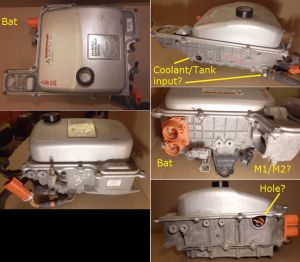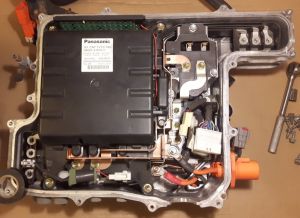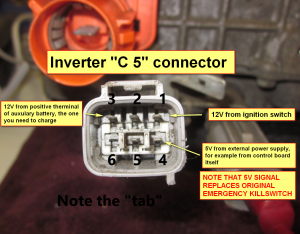Toyota Prius Gen2 Board
The Toyota Prius Gen2 Board is an open source project to repurpose 2004-2009 Toyota Prius inverters for DIY EV use. It consists of a circuit board and programming that replaces the original logic board, connected to the inverter and allows independent control of it without communicating with a Prius ECU.
Note that there is also a Toyota Prius Gen3 Board for the 2010-2015 model years.
Prius Inverter
The Toyota Prius is a hybrid vehicle. Their inverters are suitable and attractive for DIY EVs because of:
- Large part availability. Priuses have been made in large numbers for 20 years.
- High affordability. Prius inverters are available for around $150 from scrapyards everywhere.
- Durability. Toyota engineers appear to have made the inverters foolproof, many inputs and outputs gracefully handle fault conditions.
- Respectable performance. Rated for 50kW output, but tested to handle 600v, and 350+A for MG2 inverter, 250+A for MG1 inverter, 360kW total (480hp).
- Ease of repurposing. Emulating the original ECU seems reasonably feasible.
The Gen2 Prius (2004-2009 model years) has a variety of useful components inside the inverter package:
- 2 high power inverters, for the 2 motors MG1 (starter) capable of handling 250 amps, and MG2 (drive motor) capable of handling 350 amps.
- A DC-DC converter to provide 12v power supply to the automotive systems and accessories.
- A boost module to boost the 200v battery pack up to 500v, which looks to be able to function as a battery charger (wish list for future development)
- See this video for a thorough disassembly and explanation of the Gen2 Inverter (Timestamp 1:15:30): https://www.youtube.com/watch?v=Y7Vm-C4MsW8&t=4531
Control Board
As designed by Damien Maguire, the open source hardware for the control board can be purchased as blank, unpopulated boards on his website: Prius Gen2 Logic Board on EVBMW's Webshop
How To Use
The Prius Gen2 Board is suitable to control any (please add: motor types here) motors.
Note: There is a mistake in the printing on the v1 circuitboard. The parts labelled T1, T2, and T3 - which are the small black transistors in the upper right of the board - are all drawn backwards to how they need to be inserted. These parts should be installed with the flat side of the component facing the opposite direction as the printing shows. The flat side should be to the right.
Schematics, Bill of Materials, and other documentation are available on Damien's Project Github (note: flesh out bill of materials here, or post changes to Damien to update his documentation directly?)
The control board utilizes the Blue Pill (link?) microcontroller, and takes advantage of the OpenInverter.org software (link?) for control. It is also connected from the outside via the main (32 pin white) OEM connecter - try to retrieve this connecter and part of wiring loom when sourcing your inverter. Picture of connecter further down in wiki.
The control board design incorporates the use of the existing inverter Current Sensors - if FOC option is to be used (Gen 2 Transaxle MG2), bandwidth should be a multiple of control loop frequency which is 8.8kHz. (link to how to modify original setup?)
Functionality of the existing resolver is intergrated as well.
Assembly notes? Blue Pill programming notes or just links to Blue Pill section?
Try to get all the wiring harness bits that plug into the inverter when you purchase it. Else, the 32-pin connector inside the inverter part number is: 1318747-1, and the pins to wire it are: 1123343-1
Terminal Block Connection list (rough, in-progress):
Wire Connections
Control Board Pinout:
| Pin # | Designation | Description |
|---|---|---|
| TB1-1 | 12v-in | Primary 12v supply from ignition on |
| TB1-2 | GND | Primary ground connection to 12v negative. All grounds are common |
| TB1-3 | 5v VCC | 5V supply from board for use with throttle pot or hall pedal |
| TB1-4 | Throttle In | 0-5v variable voltage input from throttle pedal or pot |
| TB1-5 | Regen In | 0-5v variable voltage input. Can be used as second throttle channel or control regen from a brake pressure sensor |
| TB1-6 | GND | |
| TB1-7 | Brake In | 12v digital input from brake light switch. |
| TB1-8 | Start In | 12v digital input from "Start" position on a traditional ignition switch. Momentary action push button can be used. |
| TB1-9 | For In | 12v digital input commands motor to run in forward direction |
| TB1-10 | Rev In | 12v digital input commands motor to run in reverse direction |
| TB3-1 | +12v VCC | 12v output to inverter IGCT terminal (Not on the 32-pin connector, the red wire on the 2-pin connector next to it). |
| TB3-2 | GND | Common ground, but used to connect to inverter GND terminal (Not on the 32-pin connector, the black wire on 2-pin connector next to it). |
| TB3-3 | Phase U |
Phase U output. Connect to Inverter MUU terminal for MG2 inverter drive or GUU for MG1 inverter drive |
| TB3-4 | Phase Y | Phase V output. Connect to Inverter MVU terminal for MG2 inverter drive or GVU for MG1 inverter drive |
| TB3-5 | Phase W | Phase W output. Connect to Inverter MWU terminal for MG2 inverter drive or GWU for MG1 inverter drive |
| TB3-6 | Current U | Phase currents from inverter. Requires external divider circuit. Not required to run motor or inverter. |
| TB3-7 | Current Y | Phase currents from inverter. Requires external divider circuit. Not required to run motor or inverter. |
| TB3-8 | MG2 Enable | Connect to Inverter MSDN to run MG2 inverter or GSDN to run MG1 inverter |
| TB3-9 | MG2 Fault | Connect to MFIV for MG2 or GFIV for MG1 |
| TB3-10 | DC Bus | Connect to inverter VH to measure DC link voltage |
| TB2-1 | +5V VCC | 5v output to encoder for induction motor |
| TB2-2 | ENCA In | Encoder input A |
| TB2-3 | ENCB In | Encoder input B |
| TB2-4 | GND | Encoder ground |
| TB2-5 | HS Temp | Heatsink temp sensor input |
| TB2-6 | MOT Temp | Motor temp sensor input |
| TB4-1 | GND | Common ground |
| TB4-2 | Main Con | Main HV contactor control low side switch |
| TB4-3 | Precharge | HV precharge contactor control low side switch |
| TB4-4 | +12 V VCC | Spare 12v output |
| TB4-5 | CAN L | Can bus low signal |
| TB4-6 | CAN H | Can bus high signal |
32-pin Prius Inverter Pinout:
| Pin # | Designation | Description | Wire Color |
|---|---|---|---|
| 1 | NC | Not connected | |
| 2 | GIVA | MG1 Phase Current V | Example |
| 3 | GIVB | MG1 Phase Current V | Example |
| 4 | GUU | MG1 PWM U - Speed Signal Wave | Example |
| 5 | GVU | MG1 PWM V - Speed Signal Wave | Example |
| 6 | GWU | MG1 PWM W - Speed Signal Wave | Example |
| 7 | MIVA | MG2 Phase Current V | Example |
| 8 | MIVB | MG2 Phase Current V | Example |
| 9 | MUU | MG2 PWM U - Speed Signal Wave | Example |
| 10 | MVU | MG2 PWM V - Speed SIgnal Wave | Example |
| 11 | MWU | MG2 PWM W - Speed Signal Wave | Example |
| 12 | VH | Inverter Capacitor Voltage | Example |
| 13 | CPWM | Boost converter PWM switch signal | Example |
| 14 | GSDN | MG1 Shutdown | Example |
| 15 | VL | Boost converter input voltage | Example |
| 16 | GINV | Inverter Ground | Example |
| 17 | NC | Not connected | |
| 18 | GIWA | MG1 Phase Current W | Example |
| 19 | GIWB | MG1 Phase Current W | Example |
| 20 | CT | Boost converter temperature sensor | Example |
| 21 | GIVT | MG1 Inverter Temperature | Example |
| 22 | GFIV | MG1 Inverter Fail | Example |
| 23 | MIWA | MG2 Phase Current W | Example |
| 24 | MIWB | MG2 Phase Current W | Example |
| 25 | MSDN | MG2 Shutdown | Example |
| 26 | MIVT | MG2 Inverter Temperature | Example |
| 27 | MFIV | MG2 Inverter Fail | Example |
| 28 | OVH | Overvoltage | Example |
| 29 | CSDN | Boost converter shutdown signal | Example |
| 30 | FCV | Boost converter fail signal | Example |
| 31 | OVL | Boost converter over voltage signal | Example |
| 32 | GCNV | Boost converter ground | Example |
Additional Inverter / Converter details:
Inverter coolant enters at the front and exits the rear of the inverter housing from the o-ring port connected to the HSD cooling system reservoir.
The DC-DC charging connections on the Gen2 Prius Inverter are on the rear, they are "C5" (6 pin gray) & "C6" (1 large pin gray).
Here is what is needed for the Gen2 Inverter DC-DC to work...12v on pins #1 & #3, 5v on pin #4 of connector "C5" (gray one) and the case grounded. It is not required to have a load applied to the large gray 12v connector (C6) to obtain an output.







